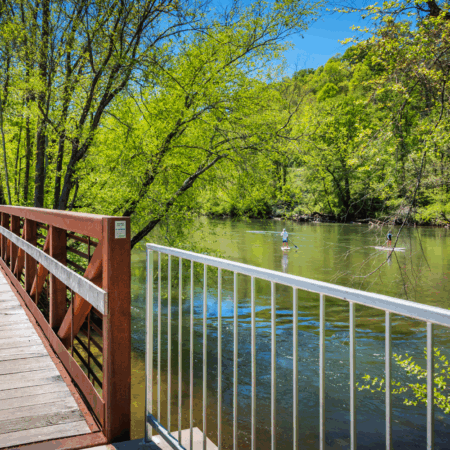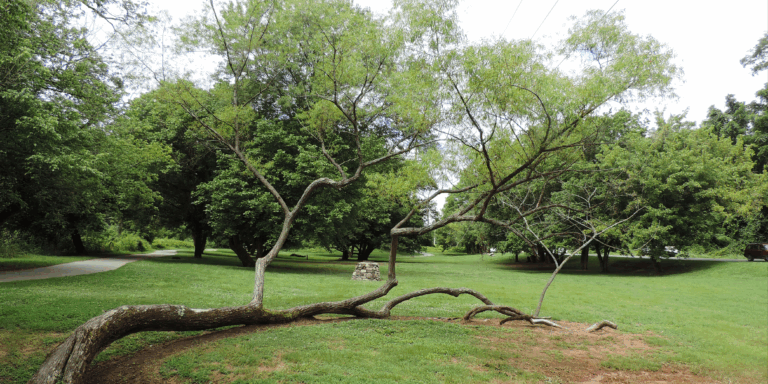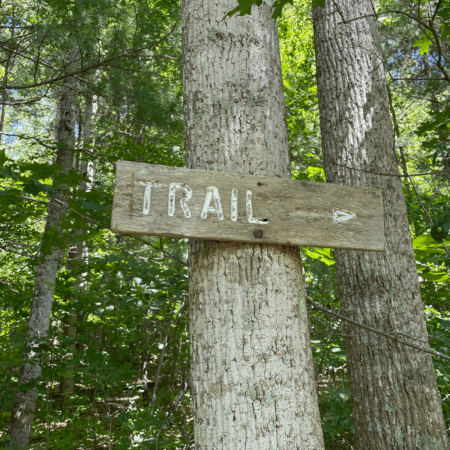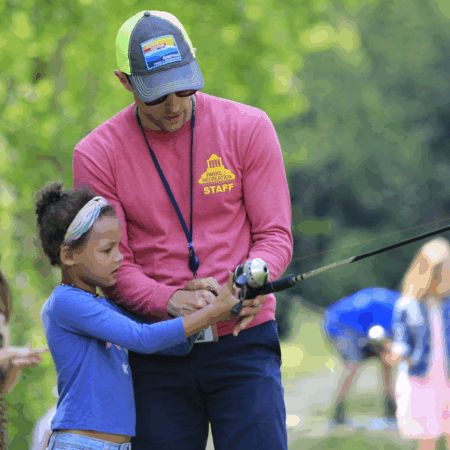It’s no secret that Ashevillians love to spend time outside. With public parks, paved greenways and natural surface trails, sport courts and fields, playgrounds, and festivals throughout the city, urban adventures and connections with nature are rarely far away. As warmer days come to the mountains, safety is crucial to navigate the lingering impacts of Tropical Storm Helene in significantly altered outdoor spaces and waterways.

River and Waterway Safety Post-Helene
Be Aware of Increased Debris: Even the most experienced paddlers, tubers, fisherfolk, snorkelers, and swimmers should be aware of dangerous debris like logs and branches that remain in waterways, often unseen under the surface. Don’t stand up in water above knee height if you can’t see the bottom, as foot entrapment in underwater debris is pretty serious. Even if you are very familiar with a stretch of water, be aware of its new challenges. Useful info can be found from the North Carolina Departments of Health and Human Services on recreational water safety and Environmental Quality on sanitary sewer overflow.
Watch for Changes in Riverbeds: Flooding has altered local riverbeds, creating new hazards like submerged obstacles, sandbars, and changes in current patterns. Be extra cautious in familiar areas.
Never Go Alone: Especially after a storm, it’s crucial to have a buddy when engaging in river activities.
Wear a Properly Fitted PFD: A U.S. Coast Guard-approved personal flotation device (PFD) is essential for any activity on or near water. Ensure it fits snugly and is in good condition.
Be Cautious Near Riverbanks: Riverbanks can become unstable and prone to collapse, especially after heavy rainfall and flooding. Maintain a safe distance.
Check Water Levels and Flow Rates: River conditions have changed dramatically since Helene moved through the riverfront on September 27. Check the U.S. Geological Survey (USGS) water gauges for real-time information on local water levels and flow rates. Avoid rivers with significantly higher or faster flows than usual.
Monitor E. coli Data: MountainTrue publishes data from local water samples each week from May to September on the Swim Guide platform that tests for the presence of microbes that pose threats to human health. Heavy rains and summer storms often result in spikes in E. coli contamination, increasing the risk to your health. Contact with or consumption of contaminated water can cause gastrointestinal illness, skin, ear, respiratory, eye, neurologic, and wound infections with the most commonly reported symptoms are stomach cramps, diarrhea, nausea, vomiting, and low-grade fever.
 Trail and Greenway Safety Post-Helene
Trail and Greenway Safety Post-Helene
Expect Trail Obstructions: Trails may be blocked by fallen trees, branches, and other debris carried by the storm. Be prepared to turn back if a trail is impassable or too risky to navigate. Do not enter areas or trails marked as closed or blocked by barriers. Water crossing and bridges may be missing or damaged.
Watch for Unstable Ground: Heavy rainfall saturated the ground, creating unstable trail surfaces, mudslides, and sinkholes. Be cautious of slippery areas and avoid steep or compromised sections, especially on paths along waterways.
Be Aware of Hidden Hazards: Floodwaters may have deposited debris like sharp objects or create deep holes hidden under mud or leaf litter. Watch your step carefully.
Report Trail Damage: If you encounter significant trail damage or hazards on a trail or greenway maintained by Asheville Parks & Recreation (APR), report it using the Asheville App. This helps ensure the safety of others.
Give Trails Time to Recover: Consider choosing less strenuous or lower-elevation trails initially, allowing more vulnerable areas time to recover and for maintenance crews to address issues.
Note Temporary Accessibility Changes: Some sections of river greenways were destroyed and may have temporary gravel walkways in their place. Accessible parking and sidewalk connectors have also been impacted.
Avoid Crossing Flooded Areas: Never attempt to cross flooded trails or streams. The water may be deeper and faster-moving than it appears, and the current can be very strong.
 General Outdoor Recreation Safety Tips
General Outdoor Recreation Safety Tips
Check Official Advisories: Before heading out, always check a trusted weather app or website for the latest closures of parks and greenways. The City of Asheville, North Carolina State Parks, and National Park Service websites are good sources. Conditions can change rapidly.
Inform Someone of Your Plans: Let a friend or family member know where you’re going and when you expect to be back. This is always good practice, but especially important when conditions might be unpredictable.
Carry a Communication Device: Ensure your phone is fully charged. Consider bringing a portable charger or a satellite communication device if you plan to be in areas with poor cell service.
Pack an Emergency Kit: Include essentials like a first-aid kit, extra food and water, a whistle, a map and compass/GPS, a multi-tool, a headlamp or flashlight with extra batteries, sun protection, and insect repellent.
Wear Appropriate Gear: Dress in layers suitable for changing weather conditions. Wear sturdy, closed-toe shoes with good traction for trails and appropriate PFDs for river activities.
Be Prepared for Wildlife Encounters: The storm displaced wildlife. Be aware of your surroundings and know how to react safely if you encounter animals like bears or snakes.
Stay Hydrated and Nourished: Outdoor activities in the summer heat, especially after potential disruptions to water sources, require extra attention to hydration and nutrition.
Check Out More Asheville Programs and Events
APR team members offer hundreds of opportunities for community members of all ages to explore, connect, discover each month – including many outdoors. Use these resources to find opportunities:
- View current Asheville Parks & Recreation program guide
- Search Asheville Parks & Recreation programs online
- Subscribe to Asheville Parks & Recreation’s newsletters
- Follow Asheville Parks & Recreation on Facebook and Instagram

 Trail and Greenway Safety Post-Helene
Trail and Greenway Safety Post-Helene General Outdoor Recreation Safety Tips
General Outdoor Recreation Safety Tips